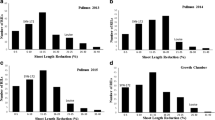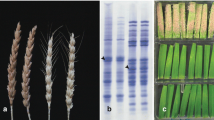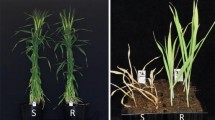Abstract
A soybean gene, Rfg1, controlling nodulation with strain USDA 205, the type strain for the fast-growing species Rhizobium fredii, was tested for allelism with the Rj4 gene. The Rj4 gene conditions ineffective nodulation primarily with certain strains of the slow-growing soybean microsymbiont, Bradyrhizobium elkanii. The F2 seeds of the cross of the cultivars Peking, carrying the alleles rfg1, Rj4, i (controlling inhibition of seed coat color) and W1 (controlling flower color), and Kent, carrying the alleles Rfg1, rj4, i-i and w1, were evaluated for nodulation response with strain USDA 205 by planting surface disinfested seeds in sterilized vermiculite in growth trays and inoculating with a stationary phase broth culture of strain USDA 205 at planting. Plants were classified for nodulation response visually after four weeks growth and transplanted to the field for F3 seed production. Flower color, purple (W1) vs white (w1), was determined in the field. The allele present at the i locus was determined by classification of F3 seed coat color. The F3 seeds were planted in growth trays and inoculated with strain USDA 61 of Bradyrhizobium elkanii to determine the genotype for the Rj4 locus. The Rfg1 and Rj4 genes were determined to be located at separate loci. Chi-square analysis for linkage indicated that Rfg1 segregated independently of the Rj4, I and W1 loci.
Similar content being viewed by others
References
Allard R W 1956 Formulas and tables to facilitate the calculation of recombination values in heredity. Hilgardia 24, 235–278.
Bojsen K, Abildsten D, Jensen E Q, Paludan K and Marcker K A 1983 The chromosomal arrangement of six soybean leghemoglobin genes. EMBO J. 2, 1165–1168.
Devine T E 1984 Inheritance of soybean nodulation response with a fast-growing strain of Rhizobium. J. Hered. 75, 359–361.
Devine T E 1985 Nodulation of soybean plant introduction lines with fast-growing rhizobial strain USDA 205. Crop Sci. 25, 354–356.
Devine T E 1987 A comparison of rhizobial strain compatibilities of Glycine max and its progenitor species Glycine soja. Crop Sci. 27, 635–639.
Devine T E and Breithaupt B H 1981 Frequencies of nodulation response alleles, Rj2 and Rj4, in soybean plant introduction and breeding lines. USDA Tech. Bull. 1628.
Devine T E, Kuykendall L D and O'Neill J J 1990 The Rj4 allele in soybean represses nodulation by chlorosis-inducing bradyrhizobia classified as DNA homology group II by antibiotic resistance profiles. Theor. Appl. Genet. 80, 33–37.
Devine T E and O'Neill J J 1989 Genetic allelism of nodulation response genes Rj1, Rj2, and RJ4 in soybean. Crop Sci. 29, 1347–1350.
Devine T E and O'Neill J J 1993 Genetic independence of the nodulation-response gene loci - Rj1, Rj2 and Rj4 - in soybean. J. Hered. 84, 140–142.
Devine T E and Reisinger W W 1978 A technique for evaluating nodulation response of soybean genotypes. Agron. J. 70, 510–511.
Dowdle S F and Bohlool B B 1985 Predominance of fast-growing Rhizobium japonicum in a soybean field in the People's Republic of China. Appl. Environ. Micribiol. 50, 1171–1176.
Elkan G H 1981 Taxonomy of the Rhizobiaceae. In Biology of the Rhizobiaceae. Eds. K L Giles and A G Atherly, pp 1–14. Academic Press, New York.
Elkan G H and Kuykendall L D 1982 Carbohydrate metabolism in Rhizobium. In Nitrogen fixation II: Biology of Rhizobium. Ed. W J Broughton. Oxford University Press, New York.
Flor H H 1947 Inheritance of reaction to rust in flax. J. Agric. Res. 74, 241–262.
Flor H H 1955 Host parasite interaction in flax rust—its genetics and other implications. Phytopathology 45, 680–685.
Heron D S, Ersek T, Krishnan H B and Pueppke S G 1989 Nodulation mutants of Rhizobium fredii USDA 257. Mol. Plant-Microbe Inter. 2, 4–10.
I J S B 1993 Validation of new species names List no 45. Int. J. Syst. Bacteriol. 43, 398–399.
Jordan D C 1982 Transfer of Rhizobium japonicum Buchanan 1980 to Bradyrhizobium gen. nov., a genus of slow-growing, root-nodule bacteria from leguminous plants. Int. J. Syst. Bacteriol. 32, 136–139.
Keyser H H, Bohlool B B, Hu T S and Weber D F 1982 Fast-growing rhizobia isolated from root nodules of soybean. Science 215, 1631–1632.
Kneen B E, Van Vikites D and La Rue TA 1987 Induced symbiosis mutants of Pisum sativum. Molecular Genetics of Plant-microbe Interactions. Eds. D P S Verma and N Brisson. pp 79–84. Martinus Nijhoff, Dordrecht.
Kuykendall L D, Saxena B, Devine T E and Udell S E 1992 Genetic diversity among Bradyrhizobium japonicum and a proposal for Bradyrhizobium elkanii sp. nov. Can. J. Microbiol. 38, 501–505.
Lie T A and Timmermans P C J M 1984 Host genes in Pisum sativum conferring resistance to European Rhizobium leguminosarum. Plant and Soil 82, 415–425.
Lewis-Henderson W R, and Djordjevic M A 1991 A cultivar-specific interaction between Rhizobium leguminosarum bv. trifolii and subterranean clover is controlled nodM, other bacterial cultivar specificity genes, and a single recessive host gene. J. Bacteriol. 173, 2791–2799.
Martinez de Drets G and Arias A 1972 Enzymatic basis for differentiation of Rhizobium into fast- and slow-growing groups. J. Bacteriol. 109, 467–470.
Mather K 1951 The Measurement of Linkage in Heredity. 2nd ed. Methuen & Co, London.
Palmer R G and Kilen T C 1987 Qualitative genetics and cytogenetics. In Soybeans: Improvement, Production, and Uses. Ed. J R Wilcox. pp 135–209. American Society of Agronomy, Madison, WI.
Scholla M H and Elkan G H 1984 Rhizobium fredii sp. nov., a fast growing bacterium that effectively nodulates soybean. Int. J. Syst. Bacteriol. 34, 484–486.
Sadowsky M J, Keyser H H and Bohlool B B 1983 Biochemical characterization of fast- and slow-growing rhizobia that nodulate soybeans. Int. J. Syst. Bacteriol. 33, 716–722.
Yakowitz S and Szidarovszky F 1989 An Introduction to Numerical Computations. 2nd ed. Macmillan Publishing, New York.
Vest G, Weber D F and Sloger C 1973 Nodulation and nitrogen fixation. In Soybeans: Improvement, Production and Uses. Ed. B E Caldwell. pp 353–390. American Society of Agronomy, Madison, WI.
Author information
Authors and Affiliations
Rights and permissions
About this article
Cite this article
Devine, T.E., Kuykendall, L.D. Genetic allelism and linkage tests of a soybean gene, Rfg1, controlling nodulation with Rhizobium fredii strain USDA 205. Plant Soil 158, 47–51 (1994). https://doi.org/10.1007/BF00007916
Received:
Accepted:
Issue Date:
DOI: https://doi.org/10.1007/BF00007916




